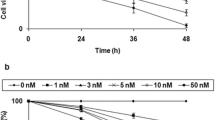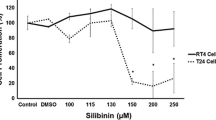Abstract
Simultaneous use of cisplatin (CIS) and gemcitabine (GEN) for treating bladder cancer has increased because of their complementary effects. However, the molecular mechanisms underlying the activities of these two antineoplastic drugs are not fully known. Here, molecular biology techniques and microscopy were used to investigate transcriptomic and morphological changes in low and high-grade urinary bladder transitional carcinoma cell lines [RT4 - wild type TP53; 5637 - two TP53 mutations, one in codon 72 (Arg-Pro) and other in codon 280 (Arg-Thr) and T24 - in-frame deletion of tyrosine 126 in the TP53 allele] simultaneously treated with CIS/GEN. Gene expression profile was evaluated by PCR arrays; cell morphology by scanning and transmission electron microscopy, and apoptosis was analyzed using fluorescent dye. Results showed concomitantly upregulation of CDKN2B (G1/S transition), GADD45A (DNA repair and apoptosis) and SERTAD1 (regulation of transcription) gene, increased number of nuclear chamfers and apoptotic cells, and reduced number of microfilaments, organelles and in the size of the nucleus in 5637 and T24 cells after simultaneous treatment with CIS/GEN. In conclusion, independently of the TP53 mutation status and tumor grade, CIS/GEN induced gene modulation accompanied by changes in cell morphologies, which confirm the antiproliferative activity of the treatment protocol. These findings help to understand the pathways modulated by these antineoplastic agents and may provide insights for anti-cancer chemotherapy.








Similar content being viewed by others
References
von der Maase H, Sengelov L, Roberts JT, Ricci S, Dogliotti L, Oliver T et al (2005) Long-term survival results of a randomized trial comparing gemcitabine plus cisplatin, with methotrexate, vinblastine, doxorubicin, plus cisplatin in patients with bladder cancer. J Clin Oncol 23:4602–4608. doi:10.1200/JCO.2005.07.757
Yuh BE, Ruel N, Wilson TG, Vogelzang N, Pal SK (2013) Pooled analysis of clinical outcomes with neoadjuvant cisplatin and gemcitabine chemotherapy for muscle invasive bladder cancer. J Urol 189:1682–1686. doi:10.1016/j.juro.2012.10.120
Wang D, Lippard SJ (2005) Cellular processing of platinum anticancer drugs. Nat rev Drug Discov 4:307–319. doi:10.1038/nrd1691
Toschi L, Finocchiaro G, Bartolini S, Gioia V, Cappuzzo F (2005) Role of gemcitabine in câncer therapy. Future Oncol 1:7–17. doi:10.1517/14796694.1.1.7
Coppée J-Y (2008) Do DNA microarrays have their future behind them? Microbes Infect 10:1067–1071. doi:10.1016/j.micinf.2008.07.003
Rentsch CA, Stenner F, Ruiz C, Bubendorf L (2015) Three genes to predict response to chemotherapy for bladder cancer: individualised cancer care at the doorstep. Eur Urol 68:968–969. doi:10.1016/j.eururo.2015.07.050
Da Silva GN, de Camargo EA, Salvadori DM (2012) Toxicogenomic activity of gemcitabine in two TP53-mutated bladder cancer cell lines: special focus on cell cycle-related genes. Mol Biol rep 39(12):10373–10382. doi:10.1007/s11033-012-1916-1
Sávio AL, da Silva GN, Salvadori DM (2015) Inhibition of bladder cancer cell proliferation by allyl isothiocyanate (mustard essential oil). Mutat res 771:29–35. doi:10.1016/j.mrfmmm.2014.11.004
Gonçalves EM, Ventura CA, Yano T, Rodrigues Macedo ML, Genari SC (2006) Morphological and growth alterations in Vero cells transformed by cisplatin. Cell Biol Int 30:485–494. doi:10.1016/j.cellbi.2005.12.007
Chen NG, Chen KT, Lu CC, Lan YH, Lai CH, Chung YT et al (2010) Allyl isothiocyanate triggers G2/M phase arrest and apoptosis in human brain malignant glioma GBM 8401 cells through a mitochondria-dependent pathway. Oncol rep 24:449–455
Nishiyama H, Watanabe J, Ogawa O (2008) p53 and chemosensitivity in bladder cancer. Int J Clin Oncol 13:282–286. doi:10.1007/s10147-008-0815-x
Da Silva GN, de Castro Marcondes JP, de Camargo EA, da Silva Passos Júnior GA, Sakamoto-Hojo ET, Salvadori DM (2010) Cell cycle arrest and apoptosis in TP53 subtypes of bladder carcinoma cell lines treated with cisplatin and gemcitabine. Exp Biol med (Maywood) 235:814–824. doi:10.1258/ebm.2010.009322
Camargo EA, da Silva GN, Gobette CP, Marcondes JP, Salvadori DM (2013) No relationship between the amount of DNA damage and the level of hMLH1 and RASSF1A gene expression in bladder cancer cells treated with cisplatin and gemcitabine. Asian Pac J Cancer Prev 4:5941–5948. doi:10.7314/APJCP.2013.14.10.5941
Rovida AFS, Endo KM, POlli AD, Bulla LMC, Scudeler EL, Abreu JAS et al (2015) Use of neem (Azadirachta indica a Juss) oil in the control of Musca domestica L.(Diptera:Muscidae) in poultry breeding farms. J World's Poult res 5:73–83
Liu Y, Kwiatkowski DJ (2015) Combined CDKN1A/TP53 mutation in bladder cancer is a therapeutic target. Mol Cancer Ther 14:174–182. doi:10.1158/1535-7163.MCT-14-0622-T
Vaezy S, Zderic V (2009) Image-guided therapy systems. Artech House INC, Washington DC
Rajcevic U, Petersen K, Knol JC, Loos M, Bougnaud S, Klychnikov O et al (2009) iTRAQ-based proteomics profiling reveals increased metabolic activity and cellular cross-talk in angiogenic compared with invasive glioblastoma phenotype. Mol Cell Proteomics 8:2595–2512. doi:10.1074/mcp.M900124-MCP200
Suresh S (2007) Biomechanics and biophysics of cancer cells. Acta Biomater 3:413–438. doi:10.1016/j.actbio.2007.04.002
Wang X, Simpson ER, Brown KA (2015) P53: protection against tumor growth beyond effects on cell cycle and apoptosis. Cancer res 75:5001–5007. doi:10.1158/0008-5472.CAN-15-0563
Wang X, Wong SC, Pan J, Tsao SW, Fung KH, Kwong DL et al (1998) Evidence of cisplatin-induced senescent-like growth arrest in nasopharyngeal carcinoma cells. Cancer res 58:5019–5022
Lu TX, Young KH, Xu W, Li JY (2016) TP53 dysfunction in diffuse large B-cell lymphoma. Crit rev Oncol Hematol 97:47–55. doi:10.1016/j.critrevonc.2015.08.006
Fechner G, Perabo FG, Schmidt DH, Haase L, Ludwig E, Schueller H et al (2003) Preclinical evaluation of a radiosensitizing effect of gemcitabine in p53 mutant and p53 wild type bladder cancer cells. Urology 61:468–473. doi:10.1016/S0090-4295(02)02156-8
Missiaglia E, Donadelli M, Palmieri M, Crnogorac-Jurcevic T, Scarpa A, Lemoine NR (2005) Growth delay of human pancreatic cancer cells by methylase inhibitor 5-aza-2. Oncogene 24:199–211. doi:10.1038/sj.onc.1208018
Chim CS, Kwong YL (2006) Adverse prognostic impact of CDKN2B hyper-methylation in acute promyelocytic leukemia. Leuk Lymphoma 47:815–825. doi:10.1080/10428190500513827
Gupta S, Takhar PP, Degenkolbe R, Koh CH, Zimmermann H, Yang CM et al (2003) The human papillomavirus type 11 and 16 E6 proteins modulate the cell-cycle regulator and transcription cofactor TRIP-Br1. Virology 317:155–164. doi:10.1016/j.virol.2003.08.008
Darwish H, Cho JM, Loignon M, Alaoui-Jamali MA (2007) Overexpression of SERTAD3, a putative oncogene located within the 19q13 amplicon, induces E2F activity and promotes tumor growth. Oncogene 26:4319–4328. doi:10.1038/sj.onc.1210195
L'Espérance S, Bachvarova M, Tetu B, Mes-Masson AM, Bachvarov D (2008) Global gene expression analysis of early response to chemotherapy treatment in ovarian cancer spheroids. BMC Genomics 9:99. doi:10.1186/1471-2164-9-99
da Silva GN, de Camargo EA, Sávio AL, Salvadori DM (2014) MRE11A and SKP2 genes are associated with the increased cytotoxicity induced by the synergistic effects of cisplatin and gemcitabine in bladder cancer cells. Mol Biol rep 41:4613–4621. doi:10.1007/s11033-014-3332-1
Author information
Authors and Affiliations
Contributions
GNS contributed to the experimental design and the interpretation of data, performed the scanning and transmission electron microscopy and PCR array experiments, and wrote the manuscript. LTF performed scanning electron microscopy. MCBS contributed to the interpretation of the data and critically read the manuscript. DMFS contributed to the experimental design, the interpretation of data, and the critical reading of the manuscript.
Corresponding author
Ethics declarations
Conflict of Interest
The authors declare that they have no competing interests.
Funding
This study was supported by the Fundação de Amparo à Pesquisa do Estado de São Paulo (FAPESP - 2008/09147–6), Fundação de Amparo à Pesquisa do Estado de Minas Gerais (CBB - APQ-01497-14) and the Conselho Nacional de Desenvolvimento Científico e Tecnológico (CNPq).
Rights and permissions
About this article
Cite this article
da Silva, G.N., Filoni, L.T., Salvadori, M.C. et al. Gemcitabine/Cisplatin Treatment Induces Concomitant SERTAD1, CDKN2B and GADD45A Modulation and Cellular Changes in Bladder Cancer Cells Regardless of the Site of TP53 Mutation. Pathol. Oncol. Res. 24, 407–417 (2018). https://doi.org/10.1007/s12253-017-0255-x
Received:
Accepted:
Published:
Issue Date:
DOI: https://doi.org/10.1007/s12253-017-0255-x




